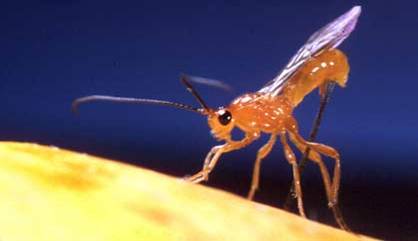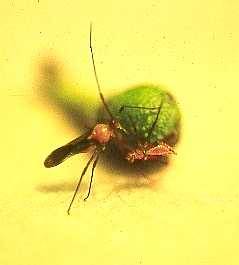Fruit Borers
Congethes (=Dichocrocis) punctiferalis
| Symptoms of damage |
-
Caterpillar bores into young fruits
-
Feeds on internal contents (pulp and seeds)
-
Dry up and fall off in without ripening
|
| Identification of pest |
- Larva - Pale greenish with pink tinge and fine hairs with dark head
- Adult - Yellowish moth with black spots on the wing and body.
|
|
Fruit borers: Deudorix (Virachola) isocrates
| Identification of pest |
-
Larvae - dark brown, short and stout, covered with short hairs
-
Adult - blusih brown butterfly. Female – V shaped patch on forewing
|
| Management |
-
Collect and destroy damaged fruits
-
Clean cultivation as weed plants serve as alternate hosts
-
Use light trap @ 1/ ha to monitor the activity of adults
-
Insecticides: malathion 50 EC 0.1% two rounds, one at flower formation and next at fruit set.
|
Fruit borer, Rapala varuna,
| Symptoms of damage |
- Caterpillar found on flower buds and fruit
|
| Identification of pest |
- Adult – metallic red coloured butterfly
|
|
| Management |
- Collect and destroy damaged fruits
- Clean cultivation as weed plants serve as alternate hosts
- Use light trap @ 1/ ha to monitor the activity of adults
- Insecticides: malathion 50 EC 0.1% two rounds, one at flower formation and next at fruit set.
|
Guava fruit fly: Bactrocera diversus
| Symptoms of damage |
-
Adults and maggots attack semi – ripe fruits
-
Oviposition punctures on fruits
-
Maggots destroy and convert pulp into a bad smelling
-
Discoloured semi liquid mass
|
| Management |
- Collect and destroy fallen and infested fruits
- Summer ploughing to expose pupa
- Use methyl eugenol lure trap (25/ha) to monitor and kill adults of fruit flies
- Prepare methyl eugenol and malathion 50 EC mixture at 1:1 ratio( take 10 ml mixture/ trap)
- Inseciticides: malathion 50 EC 0.05%
- Bait spray combining molasses or jaggery 10g/l and one of the insecticides,
- fenthion 100 EC 1ml/l
- malathion 50 EC 2 ml/l
- dimethoate 30 EC 1ml/lit, two rounds at fortnight interval before ripening of fruits
- Field release of parasitoids such as
- Opius compensatus
- Spalangia philippinensis,
- parasitoid wasp Diachasmimorpha kraussi
|
 |
| Diachasmimorpha kraussi |
|
Bark eating caterpillars, Indarbella sp
| Symptoms of damage |
-
Young trees may succumb to the attack.
-
Caterpillars bore into the trunk or junction of branches.
-
Presence of gallery made out of silk and frass.
-
Caterpillars remain hidden in the tunnel during day time come out at night and feed on the bark.
|
| Management |
-
Remove and destroy dead and severely affected branches of the tree
-
Remove alternate host, silk cotton and other hosts
-
Swab Coal tar + Kerosene @ 1:2 or Carbaryl 50 WP 20 g / l of water on the basal portion of the trunk up to 3 feet height
-
Scraping the loose bark to prevent oviposition by adult beetles.
-
Padding with tree soaked in absorbent cotton.
-
If infestations are severe then apply the copper oxychloride paste on the trunk of the tree.
-
Hook out the grub from the bore hole
-
After apply monocrotophos 36 WSC 10 to 20 ml/ hole
-
One celphos tablet (3 g aluminum phosphide) per hole
-
Apply carbofuran 3G 5 g per hole and plug with mud.
|
SAP FEEDERS
Tea mosquito bug, Helopeltis antonii
| Symptoms of damage |
- Nymphs and adults make punctures on petiole, tender shoots and fruits
- Brownish – black necrotic patches develop on foliage
- Elongate streaks and patches develop on shoots
- Corky scab formation on fruits
|
|
| Identification of pest |
- Nymph and adult: Reddish brown, elongate bug with black head, red thorax
- black and white abdomen
|
 |
Green Scale, Coccus viridis
| Identification of pest |
- Nymph: Pale lemon yellow.
- Adult – green colour, flat and oval shaped soft scale
|
 |
| Management |
- Prune and destroy the infested shoots at initial stage of infestation.
- Spray monocrotophos 1ml/lit
- After two weeks release 20 predator beetles viz.,C. montrouzieribeetle per tree.
- Encourage parasitoids viz., Aneristis sp Coccophgagus cowperi, C. bogoriensis
|
Tailed mealy bug, Ferrisa virgata
| Identification of pest |
- Nymph - Yellowish to pale white.
- Adult - Females apterous, long, slender covered with white waxy secretions
|
 |
| Management |
-
Triozhophos 2 ml+ neem oil 5 ml/1, phosalone 35 EC 1.5 ml+ neem oil 5 ml/1.
-
Release Cryptolaemous montrouzieri beetles @ 10/tree.
|
Spiraling whitefly, Aleurodicus dispersus
| Symptoms of damage |
- Nymphs and adults suck the sap from leaves
- Honey dew - development of sooty mould fungus
- Yellowing of leaves.
- Dropping of affected leaves.
|
|
| Identification of pest |
- Nymph - short glass like rods of wax along the sides of the body
- Adult - Powdery white, active during early morning hours.
|
 |
| Management |
or triazophos 40EC at 0.06%
|
-
Spray neem oil 3% or NSKE 5%
-
Release of predators viz., Coccinellid predator, Cryptolaemus montrouzieri
-
Release of parasitoids viz., Encarsia haitierrsis and E.guadeloupae
|
|

